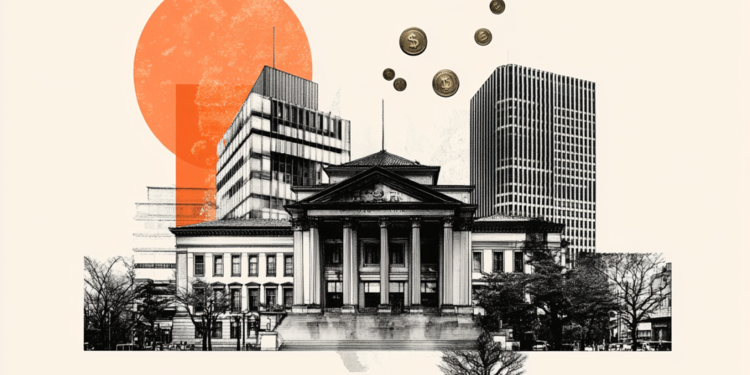The US Federal Reserve will announce its interest rate decision on Wednesday, December 13 at 19:00 GMT, and as we get closer to release time, here are expectations based on the US Federal Reserve’s forecasts. analysts and researchers from 10 large banks.
Interest rates are expected to be held for the third time in a row, but the Fed is likely to strongly oppose hopes of a large rate cut. New macroeconomic forecasts and the “dot plot” will be published. Following the publication of the statement, a press conference by Jerome Powell will take place.
ANZ
Inflation has performed better than the FOMC expected in September, which will likely result in a reduction in forecasts for inflation and the FFR. The dot plot could be at least 50 basis points lower over the next year relative to the September projection. Powell will have to maintain a hawkish stance as the fight against rising inflation is far from over and the FOMC does not want to risk financial conditions easing too much, which could undermine its target of get inflation back to 2% in a sustainable way.
Deutsche Bank
We expect the central bank to keep rates stable and signal a soft tightening bias. Later, they foresee a slight recession starting in the first quarter of 2024 and a first rate cut in June.
Rabobank
We expect the FOMC to remain unchanged, underline its dependence on data and its intention to proceed cautiously. During the press conference, we expect Powell to repeat that it would be premature to confidently conclude that monetary policy has reached a sufficiently tight stance or to speculate on when policy might ease. However, we expect the FOMC to remain on hold in the coming months because it believes a soft landing is on the horizon and is not likely to risk it by raising rates further. However, we believe unemployment will rise more than the FOMC anticipated, setting them up for a first rate cut in June. Meanwhile, given the Fed’s reliance on data, it will remain very difficult to convincingly oppose market expectations of an early rate cut.
TDS
The Fed is expected to extend its pause on rate hikes for a third straight meeting. In our view, the recent decline in yields poses a challenge to the Fed’s communications, as the likely dovish tone expressed through the statement and Summary of Economic Projections could overstate the price of rate cuts. In light of this, we hope Powell rejects the idea that the mission has been accomplished. The Fed will not send a hawkish signal, especially with a downward revision to the Summary Economic Projections. While this will weigh on the Dollar on Fed Day, we caution that data remains the key. The data as a whole points to a further decline in the USD, but we are cautious about chasing it through the end of the year and into the US CPI. The general trend of the USD is bearish, with the risk of short-term recoveries occurring in the short term.
Nordea
We expect that the new economic projections will revise the inflation outlook downwards, but the GDP outlook upwards. They will eliminate the additional rate hike and continue to demand 50 basis point cuts next year. Much less than the 125 basis points that the market expects. It is not yet known if it will be a big enough wake-up call for the market. This is at least the sixth time the market has priced in short-term rate cuts this cycle, and we’re not sure they got it right this time either.
SocGen
Fed officials tend to keep monetary policy options open. They should not contemplate further hikes after the December FOMC meeting, but at the same time, they want to avoid increasing market speculation about the timing and magnitude of cuts in 2024. It is a delicate balancing act, which is achieved indicating that they are not yet debating cuts and maintaining the two cuts indicated in the September dot plot.
ING
The Fed is expected to keep the federal funds target between 5.25% and 5.50%. The biggest news will probably be in the forecasts of individual Fed members: to what extent will they try to support the market perception that major rate cuts are coming? We strongly suspect that there will be a strong setback in this regard. We expect the Fed to maintain a relatively optimistic economic assessment with the same 50 basis points of rate cuts in 2024 that they outlined in their September forecasts, albeit from a lower level given that the last 25 basis points hike in December that they forecast last time is not going to happen. We believe the Fed will eventually take a more dovish stance, but this may not happen until the end of the first quarter of 2024. For now, the US economy continues to perform well and the labor market remains tight, but there are increasingly more signs that the Fed’s interest rate hikes and subsequent tightening of credit conditions are beginning to have the desired effect. We expect rate cuts of 150 basis points in 2024 and another 100 basis points in early 2025.
Citi
The Fed is expected to keep the policy rate unchanged, but communication and revisions to the dot plot in the Summary of Economic Projections could be somewhat muted. We expect the Fed to revise 2023 core CPI inflation downward, and with officials missing the last planned hike in 2023, the 2024 and 2025 Summary Economic Projection midpoints are likely to drop by 50 basis points, up to 4.625% and 3.375%, respectively. The 2024 dot would then imply 75 basis points of cuts in total by 2024, more than the dots showed in September. During the press conference, Chairman Powell will likely say that it is premature to speculate on cuts and that the Committee will decide meeting by meeting whether it needs to hold interest rates or raise the policy rate.
CIBC
The FOMC has no reason to change course and is too divided on what lies ahead to offer definitive guidance, although Powell’s team is likely not as dovish as the market on the timing of the first rate cut. .
Westpac
It is almost a given that the FOMC and Chairman Powell will continue to highlight that inflation risks remain their main objective. Although the press conference is also likely to assess the downside risks to growth and the labor market, as well as the recognition that if nominal interest rates are not cut, the real policy stance will continue to tighten as inflation decreases. If our March start date for cuts is correct, it is likely that activity will take over from inflation at the January meeting.
Source: Fx Street
I am Joshua Winder, a senior-level journalist and editor at World Stock Market. I specialize in covering news related to the stock market and economic trends. With more than 8 years of experience in this field, I have become an expert in financial reporting.







